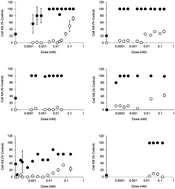A novel class of ruthenium-based photosensitizers effectively kills in vitro cancer cells and in vivo tumors†
Abstract
The photo-physical and photo-biological properties of two small (<2 kDa), novel Ru(II) photosensitizers (PSs) referred to as TLD1411 and TLD1433 are presented. Both PSs are highly water-soluble, provide only very limited luminescence emission at 580–680 nm following excitation at 530 nm, and demonstrate high photostability with less than 50% photobleaching at radiant exposures H = 275 J cm−2 (530 nm irradiation). It was previously shown that these two photosensitizers exhibit a large singlet oxygen (1O2) quantum yield (Φ (Δ) ∼0.99 in acetonitrile). Their photon-mediated efficacy to cause cell death (λ = 530 nm, H = 45 J cm−2) was tested in vitro in colon and glioma cancer cell lines (CT26.WT, CT26.CL25, F98, and U87) and demonstrated a strong photodynamic effect with complete cell death at concentrations as low as 4 and 1 μM for TLD1411 and TLD1433, respectively. Notably, dark toxicity was negligible at concentrations less than 25 and 10 μM for TLD1411 and TLD1433, respectively. The ability of the PSs to initiate Type I photoreactions was tested by exposing PS-treated U87 cells to light under hypoxic conditions (pO2 < 0.5%), which resulted in a complete loss of the PDT effect. In vivo, the maximum tolerated doses 50 (MTD50) were determined to be 36 mg kg−1 (TLD1411) and 103 mg kg−1 (TLD1433) using the BALB/c murine model. In vivo growth delay studies in the subcutaneous colon adenocarcinoma CT26.WT murine model were conducted at a photosensitizer dose equal to 0.5 and 0.2 MTD50 for TLD1411 and TLD1433, respectively. 4 hours post PS injection, tumours were irradiated with continuous wave or pulsed light sources (λ = 525–530 nm, H = 192 J cm−2). Overall, treatment with continuous wave light demonstrated a higher tumour destruction efficacy when compared to pulsed light. TLD1433 mediated PDT resulted in statistically significant longer animal survival compared to TLD1411. Two-thirds of TLD1433-treated mice survived more than 100 days (p < 0.01) whereas TLD1411-treated mice did not survive longer than 20 days. Here we present evidence that two novel PSs have very potent photo-biological properties and are able to cause PDT-mediated cell death in both in vitro cell culture models and in vivo tumour regression.


 Please wait while we load your content...
Please wait while we load your content...